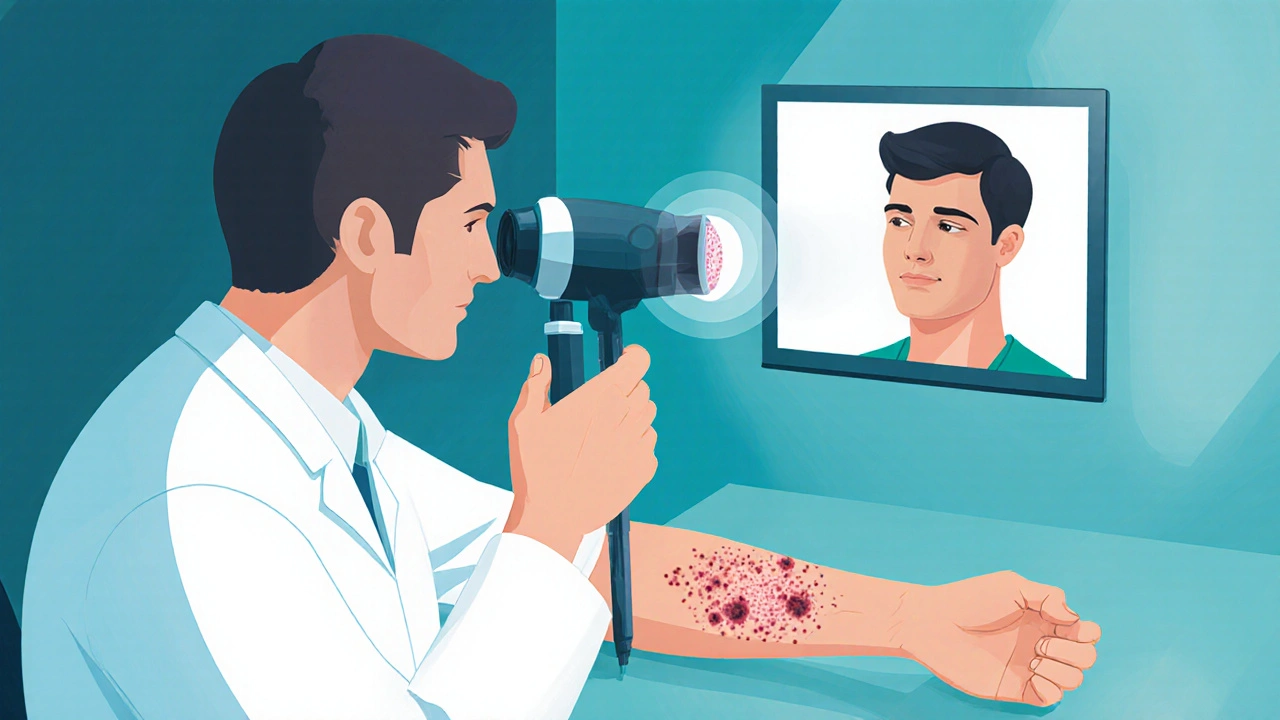Skin Condition Checker
Your Potential Skin Condition
Why See a Dermatologist?
Treatment Options Available
Common Skin Conditions and Why Professional Care Matters
Acne
Prescription treatments available
Eczema
Targeted therapy options
Psoriasis
Biologic treatments
Skin Cancer
Early detection crucial
Key Takeaways
- Professional diagnosis catches serious issues early.
- Dermatologists offer targeted prescriptions that over‑the‑counter products can’t match.
- Teledermatology expands access without sacrificing expertise.
- Choosing the right specialist saves time, money, and skin irritation.
- Regular check‑ups keep chronic conditions under control.
Most of us have tried a quick fix for a rash, a stubborn breakout, or an odd spot on the face. The problem is, DIY solutions often miss the underlying cause, and that can turn a simple irritation into a long‑term issue. Dermatologist is a medical specialist who focuses on diagnosing and treating skin, hair, and nail disorders. When you schedule an appointment, you’re not just paying for a skin check-you’re investing in expertise that can spot cancer early, match the right medication to your genetics, and design a plan that works for your lifestyle. Below is a step‑by‑step look at what you actually gain by seeing a dermatologist for any skin condition.
Professional Diagnosis Beats Guesswork
Skin issues can look similar but stem from completely different triggers. A red, scaly patch could be eczema, psoriasis, or the early stage of skin cancer. Without a trained eye, you might keep slapping on moisturizers that do nothing or, worse, worsen the condition. Dermatologists use visual inspection, dermoscopy, and sometimes a simple skin biopsy to confirm the exact problem. This accuracy means you get a treatment that targets the root cause, not just the symptoms.
Common Conditions That Benefit From Expert Care
Here are a few everyday skin conditions and why a specialist makes a difference.
- Acne affects up to 85% of teenagers and many adults, often persisting despite over‑the‑counter cleansers. Professional treatment can include prescription‑strength retinoids, hormonal therapy, or light‑based procedures, which dramatically reduce scarring.
- Eczema (atopic dermatitis) is a chronic, itchy inflammation that can flare with stress, allergens, or temperature changes. Dermatologists can prescribe topical steroids, calcineurin inhibitors, and recommend trigger‑avoidance plans that DIY creams rarely address.
- Psoriasis is an autoimmune disorder that produces thick, silvery plaques. Left untreated, it can lead to joint pain (psoriatic arthritis). Targeted biologic drugs, which require specialist monitoring, can clear up to 90% of lesions.
- Skin cancer-including basal cell carcinoma, squamous cell carcinoma, and melanoma-often starts as a small, irregular mole. Early removal by a dermatologist greatly improves survival rates and reduces surgical complexity.

In‑Person vs. Teledermatology: What’s the Difference?
Not everyone can drop by a clinic during work hours. Teledermatology bridges that gap, letting you send clear photos and receive a diagnosis within days. While remote care can’t replace a full‑body exam, it works well for follow‑ups, medication adjustments, and minor rashes.
| Aspect | In‑Person Visit | Teledermatology |
|---|---|---|
| Physical Exam | Full skin inspection, dermoscopy, biopsies | Photo‑based assessment, limited to visible areas |
| Turnaround Time | Immediate feedback during appointment | Typically 24‑48hours for a written report |
| Procedures | Can perform excisions, laser therapy, cryotherapy | Prescription delivery only, no procedures |
| Cost | Higher due to facility use | Often lower; many insurers cover virtual consults |
| Best For | New, suspicious, or complex conditions | Follow‑up, medication tweaks, mild rashes |
Treatment Options You Won’t Find on the Shelf
When a dermatologist prescribes a medication, it usually falls into one of two buckets: Prescription Medication or Cosmetic Procedure. Prescription meds can be topical (creams, gels) or systemic (pills, injections) and are formulated to penetrate deeper skin layers or modulate the immune system. Cosmetic procedures-like laser resurfacing, chemical peels, or microneedling-address texture, pigment, and scarring that creams can’t fix. Both routes are tailored after a thorough assessment, ensuring you avoid the trial‑and‑error cycle that often hurts both skin and wallet.
How to Choose the Right Dermatologist
Not every skin doctor offers the same level of care. Here’s a quick checklist.
- Board certification: Look for “American Board of Dermatology” or equivalent in your country.
- Specialty focus: Some practices specialize in pediatric dermatology, others in cosmetic work. Pick one that aligns with your need.
- Location & accessibility: Proximity matters for follow‑ups; many offices now offer evening slots.
- Patient reviews: Real‑world feedback often highlights bedside manner and office efficiency.
- Insurance compatibility: Verify coverage before booking to avoid surprise bills.

What to Expect at Your First Appointment
First visits usually follow a simple flow.
- Medical history: You’ll discuss past skin issues, allergies, and any medications you’re taking.
- Visual exam: The dermatologist uses a bright lamp and may bring a dermatoscope to look for subtle patterns.
- Diagnostic tools: If something looks suspicious, a quick shave biopsy might be taken. Results often come back within a week.
- Treatment plan: You’ll receive a written plan that includes prescription details, lifestyle tips, and follow‑up timing.
Most patients leave feeling empowered, because the doctor explains why each step matters-not just what to do.
Why DIY Skin Care Often Falls Short
Internet blogs promise miracle cures, but they rarely address the individual variability of skin. Over‑the‑counter products may contain irritants, and self‑diagnosis can delay critical treatment. For chronic conditions like eczema or psoriasis, using the wrong steroid strength can thin the skin permanently. A dermatologist’s guidance ensures you’re not over‑using potent drugs and that you’re using the right product for your skin type.
Making the Most of Your Dermatology Visits
To get the best outcome, come prepared.
- Bring a list of every product you currently use-from soaps to serums.
- Take clear photos of the problem area if you’ve had it for weeks.
- Write down any triggers you suspect (stress, diet, weather).
- Ask questions about side effects, how long a medication will take to work, and what to do if you don’t see improvement.
Follow‑up appointments are not a sign of failure; they’re a chance to fine‑tune the plan and catch any new changes early.
Frequently Asked Questions
How often should I see a dermatologist if I have acne?
For moderate to severe acne, a visit every 4‑6weeks is common until the regimen stabilizes. After that, a check‑in every 3‑6months is enough to monitor progress and prevent scarring.
Can teledermatology diagnose skin cancer?
Initial triage can be done remotely-high‑resolution photos may flag suspicious lesions. However, a definitive diagnosis and removal still require an in‑person exam and possibly a biopsy.
Are prescription creams safe for long‑term use?
When used as directed, many prescription topicals are safe for months or even years. The key is regular follow‑up-your dermatologist will adjust potency to avoid skin thinning or hormone imbalance.
What’s the difference between a dermatologist and a cosmetic skin specialist?
A dermatologist is a medical doctor trained to diagnose disease and perform procedures. A cosmetic specialist may focus solely on aesthetic treatments and might not have medical training to manage disease‑related issues.
Do I need a referral to see a dermatologist?
In many regions you can book a direct appointment, but some insurance plans require a primary‑care referral for coverage. Check your policy before scheduling.






Comments
Caley Ross
October 5, 2025 AT 19:33 PMDerm docs just know their stuff.
Bobby Hartono
October 6, 2025 AT 07:30 AMHonestly, reading through this whole post made me think about how many times I've tried random creams that just made my skin worse. I remember the first time I tried that "miracle" spot treatment from some sketchy YouTube channel – my face ended up looking like a rash from a bad allergic reaction. Then there was the period when I thought I could cure my eczema by just drinking kombucha and applying avocado mash, which only left me with greasy pores. It wasn't until I finally booked an appointment with a board‑certified dermatologist that I learned about prescription‑strength topical steroids and the importance of a proper skin barrier routine. The doc explained that over‑the‑counter stuff often lacks the potency needed to break the cycle of inflammation. He also showed me how to use a gentle cleanser, a non‑comedogenic moisturizer, and a targeted treatment in a specific order – something I would never have figured out on my own. Since then, my breakouts have decreased dramatically and the occasional flare‑ups are now manageable within a week. I also appreciate that the dermatologist ran a quick dermatoscopic exam to rule out any early signs of skin cancer, which gave me peace of mind. The whole experience taught me that DIY solutions are fine for minor issues, but serious or persistent conditions deserve professional attention. In the end, investing in a proper diagnosis saved me both money and a lot of emotional distress. If you're on the fence, just think about the long‑term benefits of getting the right treatment first. Trust me, your future self will thank you for making that appointment. Also, having a written treatment plan helped me stay consistent, because I no longer guess what to apply each night. The dermatologist even recommended a follow‑up schedule that fits my lifestyle, so I never feel abandoned after the initial visit. All in all, seeing a specialist turned my skin health around in ways that any online tip could never achieve.
George Frengos
October 6, 2025 AT 19:26 PMIt is commendable how you have highlighted the value of professional assessment. A qualified dermatologist can discern subtle clinical signs that laypersons often overlook. By establishing a precise diagnosis, the practitioner facilitates a treatment protocol tailored to the individual's physiological profile. Moreover, the integration of evidence‑based therapies ensures optimal outcomes while minimizing adverse effects. Regular follow‑ups further reinforce adherence and allow timely adjustments as necessary. In summary, the benefits of specialist care extend beyond mere symptom relief to encompass long‑term skin health preservation.
Jonathan S
October 7, 2025 AT 07:23 AMWow, this article really rolls out the red carpet for dermatologists 🙄. I mean, sure, they’re “medical experts,” but sometimes the hype feels a bit over‑the‑top 😒. People get convinced that every little pimple needs a credentialed specialist, when a simple cleansing routine might do the trick. Still, I’ll give credit where it’s due – catching skin cancer early is a legit lifesaver 💯. Just don’t let the fear‑mongering drive every minor rash into a pricey appointment. Balance is key, folks.
Charles Markley
October 7, 2025 AT 19:20 PMFrom a dermatological epistemology standpoint, the discourse necessitates an ontological reclassification of cutaneous pathology. The heuristics employed by laypersons lack the requisite diagnostic granularity, thereby engendering a proliferation of iatrogenic sequelae. Leveraging pharmacologic stratification and procedural sophistry, board‑certified dermatologists instantiate a paradigm shift, optimizing therapeutic indices while attenuating systemic exposure. In essence, the clinician acts as a locus of integrative biomedical synthesis, transcending superficial remedial heuristics.
L Taylor
October 8, 2025 AT 07:16 AMOne might ponder the essence of skin as the boundary between self and world it is a veil that both conceals and reveals the inner flux of health and disease the dermatologist serves as a guide through this mutable terrain offering insights that go beyond the superficial and tap into the deeper currents of physiological balance
Matt Thomas
October 8, 2025 AT 19:13 PMLook mate the proper way to write this post is "dermatology" not "dermatologist" and you should use "their" not "there" also stop using "u" it looks unprofessional. Seriously, proper punctuation and spelling matter even in casual forum posts. Get it right next time.
Nancy Chen
October 9, 2025 AT 07:10 AMThe whole industry is a front for a hidden agenda, the big pharma and skin‑care conglomerates are feeding us lies about “professional care” while they control the data streams. They want us to think only a certified doctor can help, but the truth is buried in the deep web where the real cure formulas are hidden from the masses. Stay woke.
Jon Shematek
October 9, 2025 AT 19:06 PMTotally hear you – it’s crazy how much misinformation floats around. At the same time, getting a legit check‑up can catch real problems early, which is a win‑win. Keep sharing those eye‑opening insights, they help people cut through the noise!
Mike Rylance
October 10, 2025 AT 07:03 AMIt is encouraging to see the emphasis on evidence‑based dermatological care. By fostering collaboration between patients and specialists, we can enhance adherence and achieve sustainable skin health outcomes. Maintaining a respectful dialogue ensures that each individual feels supported throughout their treatment journey.
Becky B
October 10, 2025 AT 19:00 PMWhile I appreciate the professionalism highlighted here, it is essential to recognize the covert influence of external agencies that steer public perception toward certain medical practices. By staying vigilant and questioning the narrative, we protect our autonomy and health.
Aman Vaid
October 11, 2025 AT 06:56 AMAllow me to clarify: the data unequivocally supports that dermatological interventions, when appropriately administered, produce superior outcomes compared to self‑managed regimens. Ignoring this consensus does not constitute independent thinking; it reflects a misapprehension of the empirical evidence.